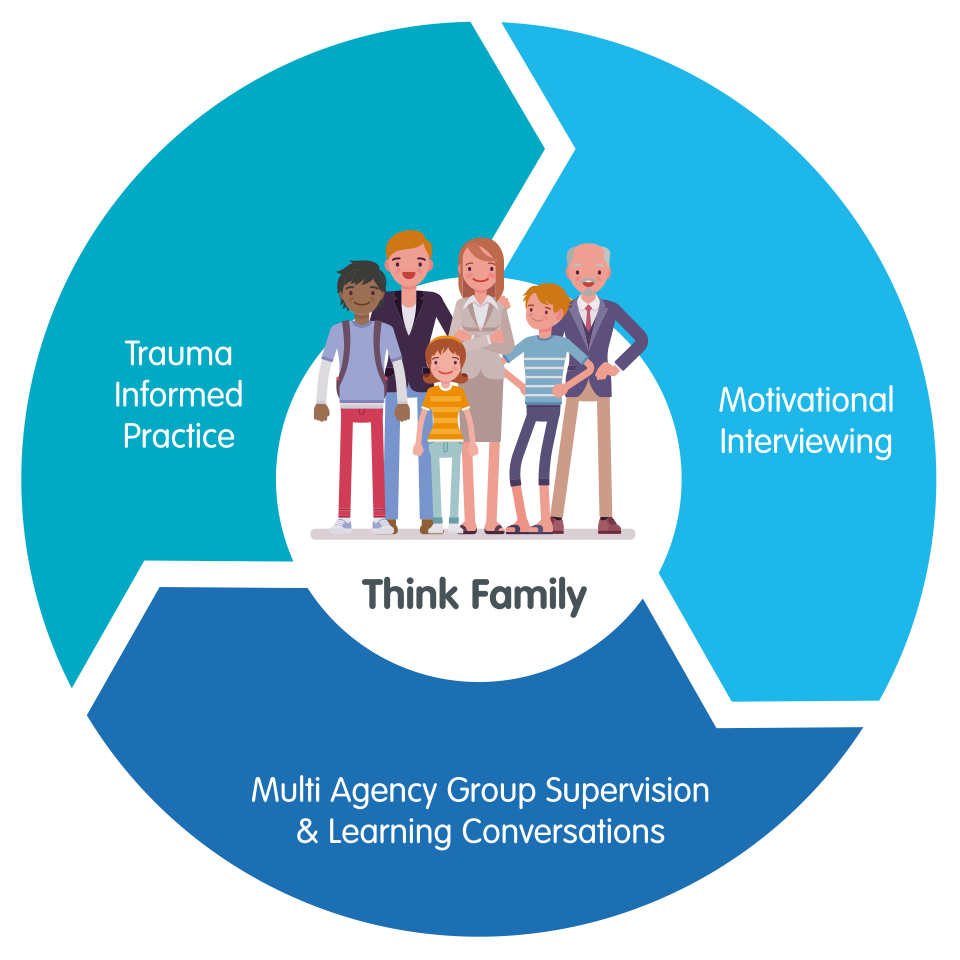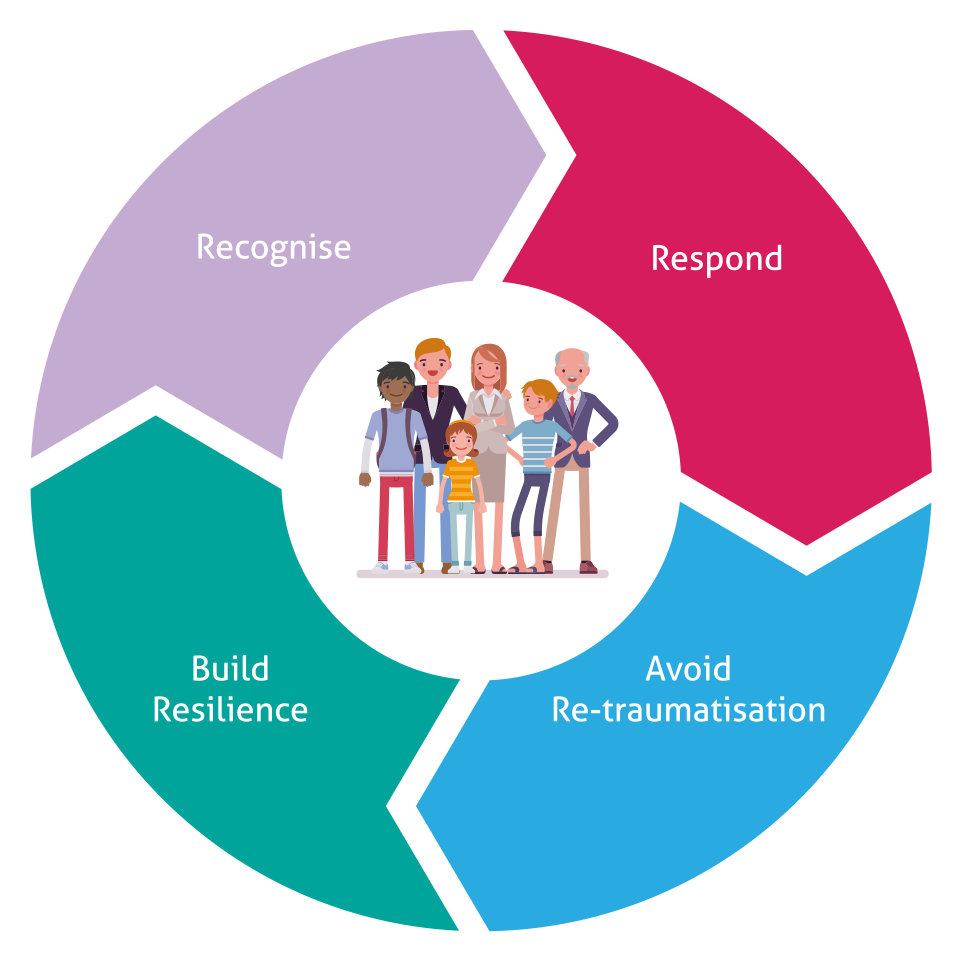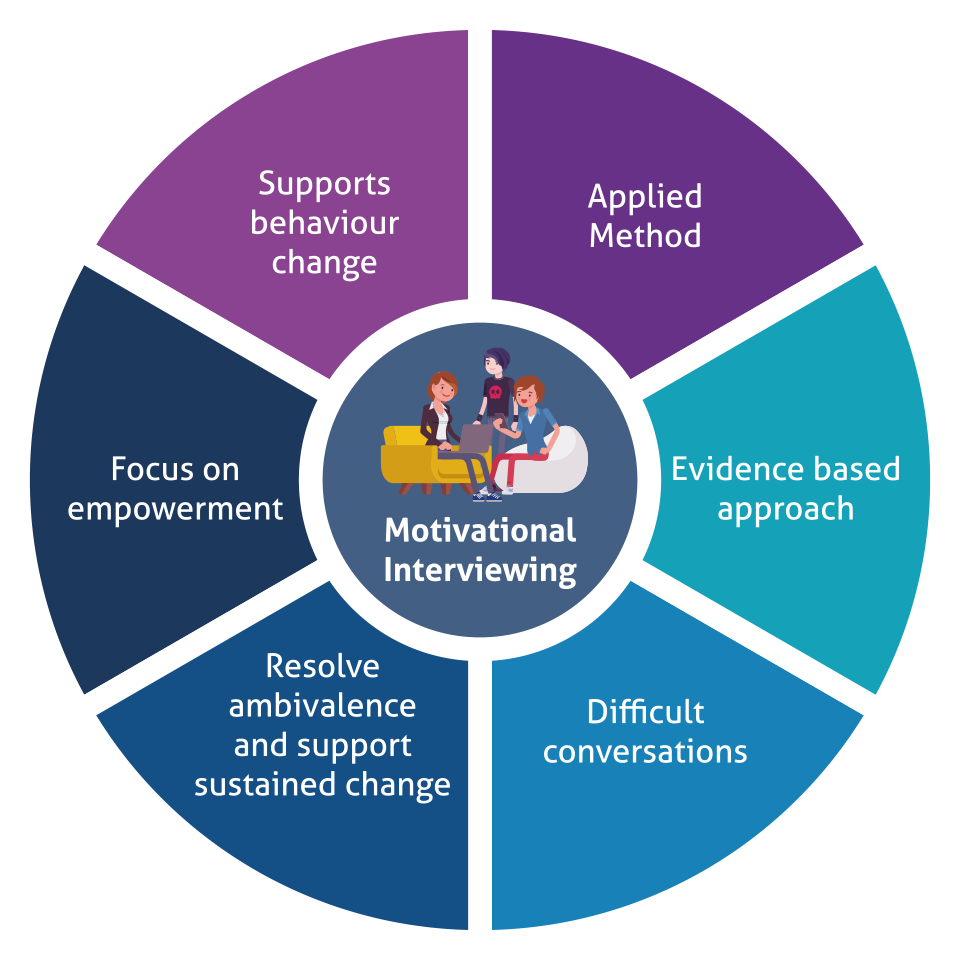The Model of Practice
These interchangeable frameworks, when woven together, are a way of responding to trauma as a whole workforce approach. They support a wider culture change in practice to help us:
- develop innovative solutions
- develop a shared language
- work in a common and consistent way.

Think Family
Think Family underpins the values and principles of Our Way of Working.
“Thinking Family” is an approach whereby in their day to day roles, all practitioners whether working with adults or children are identifying, considering and appropriately responding to the safeguarding needs of all family members. Think Family places a responsibility on all practitioners to respond to identified issues from signposting and referral, through to providing services. It requires professionals to communicate with others working with different family members and coordinate those efforts for the best outcomes of the whole family.
To find out more, please visit the Safeguarding Children Partnership
Trauma Informed Practice
Our Way of Working considers trauma to be deep and profound. It focuses on all aspects of adversity across the continuum of need. For example, from the diagnosis of serious illness, poverty, death and loss to abuse and neglect. It enables us to practice in a trauma informed way to understand how trauma can impact families through generations and everyday lives.
Through working in this way we start to develop our shared language and understanding, shifting our thinking from asking ‘what’s wrong’ to ‘what’s happened’. This enables us to consider the root causes of the pain, behaviours and difficulties children, young people and adults are experiencing.
Four key principles outline how we practice in a trauma informed way:
-
Recognise
We recognise that trauma impacts individuals in different ways over different periods of their lives. The display of trauma is often seen in different behaviours and is not always reflective of the root cause of what has happened.
Adverse Childhood Experiences (ACEs) support us in recognising trauma. Research has shown ACEs are powerful indicators of trauma in a person’s life. ACEs were identified following a study in the USA between 1995 – 1997 as:
- Verbal abuse
- Sexual abuse
- Physical abuse
- Parental separation and divorce
- Domestic abuse
- Mental illness
- Alcohol and substance abuse
- Incarceration
(Centre for Public Health, Liverpool, John Moore’s University, 2016)
Research has shown that adverse childhood experiences and trauma can have an impact into adult life. This can include mental health, physical health, learning and socialisation.
-
Respond
We can respond to trauma in an informed and appropriate way through:
- Not focusing on the presenting issue or behaviour but by asking ‘why has this happened?’
- Considering the person’s story, how this impacts on the child/young person/parent /carer and their family
- Recognising and acknowledging their trauma, being person centred
- Supporting children, young people and adults to understand what is happening in their world
- Using motivational interviewing approaches
- Considering the environment to ensure it feels safe and avoids re-traumatisation
- Considering how our system, policies and processes can become trauma informed. For example, supervision policies, behaviour policies, codes of conduct and self evaluation tools.
-
Avoid Re-traumatisation
Working in a trauma informed way, understanding the needs of the children, young people and families we are working with, will inform how we work together to avoid re-traumatisation. This will be through considering the following:
- Understanding triggers to trauma from the past
- Ensuring strengths based empowering approaches which are developmentally appropriate
- Using sensitive and developmentally appropriate language
- Considering how our systems can align and respond
- Consider the physical environment, policies and procedures
- Using motivational interviewing
- Building trusting and consistent relationships
- Empowering the child and family with a sense of safety and control through listening to their views
- Identifying and building on positive factors
-
Build Resilience
- Through identifying the risks and protective factors for children we can put in place approaches and interventions to build resilience to prevent long term ACE and trauma consequences to support healthy development and learning
- Supporting parents and carers to understand their own trauma we can start to build resilience and work towards preventing the impact of future generational ACEs and trauma
- Take a whole family approach and use motivational interviewing skills
- Use learning conversations to develop partnership collaboration to support resilient approaches and interventions
- Identify the safe base for a child/young person considering the home, school and community (see diagram)
(Beacon House, 2019)

Motivational Interviewing (MI)
Is a way to have a difficult conversation with people who feel unable to or are struggling to make changes in their lives. It is a positive, strengths and evidence based way of working with people to help them understand their own need for change.
Miller and Rollnick, 2013, found a confrontational approach rarely works but using a different approach, gaining rapport, expressing empathy, understanding and focusing on self-determination, change was more likely to occur.
The four stages of MI:
Engage – Understanding a person’s view
Focus – Creating a shared agenda and priorities
Evoke – Exploring conversation about change
Plan – Change plan and SMART goals
(Miller and Rollnick, 2013)
We can use MI in all our conversations with colleagues as well as with children and families.

Learning conversations
It is a framework for professionals to learn, develop, reflect and review how they are working with a child or young person in order to problem solve together, think differently to support progressing a child’s plan.
It is not supervision, it does not provide a framework for decision making. It focuses on professional continuous development, sharing learning and reflection.
To find out more visit learning conversations
Multi agency group supervision
The framework is to support all partners working with a child/young person to jointly assess need, risk and vulnerability. It enables joint decision making, strengthens how we can work in a preventative way to develop a plan to address need and risk.
There are seven stages to the framework and multi-agency chronologies are a key part of this. The framework draws on the core model of Our Way of Working including trauma informed practice and motivational interviewing.
The graphic illustrates how the framework can be undertaken within the seven stages influenced by the work of Wonnacott & Wallbank, 2016 and Keller & Protinsky, 1986.
To find out more visit multi agency group supervision

